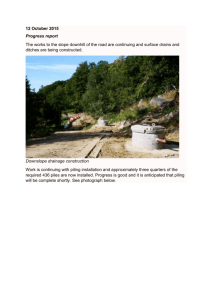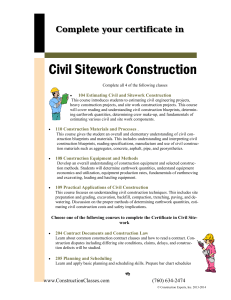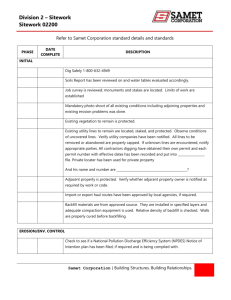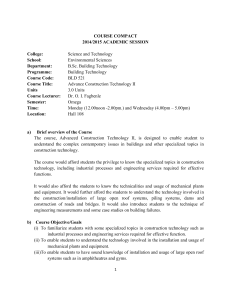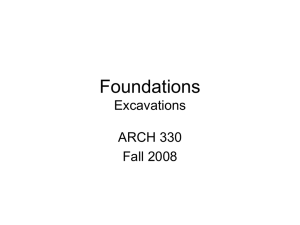Chapter 4: Measuring Sitework, Excavation, and Piling
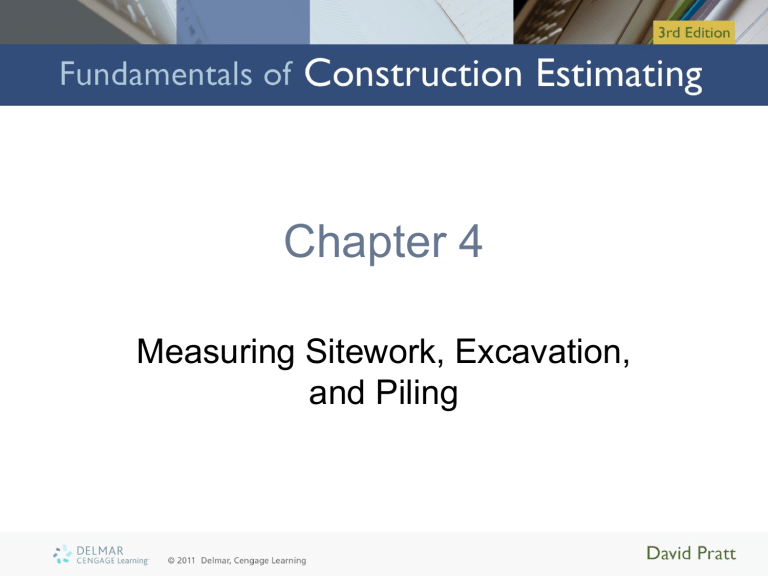
Chapter 4
Measuring Sitework, Excavation, and Piling
Objectives
• Upon completion of this chapter, you will be able to:
– Determine the likely soil conditions at a site by studying a soils report
– Explain the use of swell factor and compaction factor when calculating volumes of excavation and backfill
Objectives (cont’d.)
– Define bank measure and explain how it applies to sitework takeoffs
– Describe and use the “grid method” of calculating cut and fill volumes
– Describe and use the “section method” of calculating cut and fill volumes
– Explain how piling work is measured in a takeoff
Objectives (cont’d.)
– Explain how trenches and basements are measured in a takeoff
– Complete a manual takeoff of sitework
– Complete a computer takeoff of sitework using Excel spreadsheets and MC 2 ICE software
Generally
• Measuring sitework and excavation work
– Different from measuring most other work
• Current site condition may not be provided
• Dimensions and shape of excavations may not be disclosed
– Estimators must assess requirements before measuring site work
Soils Report
• Provides subsurface condition information
– Usually not a bid document
– Includes data for foundation system design
• Comments on sample soils report
– Topsoil, moisture content, soil compaction, slope ratio, drainage, etc.
Bank Measure, Swell, and
Compaction Factors
• Extracted soil
– Less dense and will occupy more space
• Compaction factor
– Difference between hole volume and fill material volume
• Bank measure
– Obtained using hole dimensions
Excavation Safety Considerations
• Potential danger to workers
– Cave-ins
• OSHA’s Construction Safety and Health
Regulations
– Requires shoring systems or cutting back sides to a safe angle
• Strongly enforced
Use of Digitizers
• Electronic devices
– Enables user to take measurements from drawings
• Input directly into computer program
• Digitizer types
– Sonic
– Tablet
On-Screen Takeoff
• Eliminates need for paper-based printouts
– Number of formats
– Cost savings
– Speed
– Convenience
• Plans still have to be drawn to scale
Measuring Notes —Excavation and Backfill
• Include:
– Measure in cubic yards or cubic meters
“bank measure”
– Classify and measure separately
• Excavations
• Materials
• Hand excavation
• Disposal of surplus soil
Calculation of Cut and Fill
Using the “Grid Method”
• Requires a site survey
– Showing elevation of existing grade
• Each intersection point on the grid
• Plotted at each intersection point
• Depth of cut can be obtained at each point
– Refer to Figures 4.1 and 4.2
• Accuracy depends on grid spacing
Calculation of Cut and Fill
Using the Section Method”
• Mostly used with long, relatively narrow areas of cut and fill
– Road and railroad construction
• Results quality depends on accuracy of plotting
– Refer to Figure 4.3
Trench Excavations
• Formula for trench volume:
– Trench Volume = Length of Trench Centerline
× Average Width of Trench × Average
Depth of Trench
– Refer to Figure 4.4
• Sides of trenches often cut-back due to:
– Safety reasons
– Soil will not stand vertically
Trench Backfill
• Volume of backfill for a trench
– Generally equal to volume of excavation minus volume of what is to be contained
– Surplus occurs when volume of excavation exceeds amount required for backfill
• Item for disposal of surplus material is required
Greater Accuracy
• Formula used to calculate volume of excavation:
– Usually sufficient
– Some situations require more accuracy
• Example: pit and basement excavations
Measuring Notes —Piling
• Often subcontracted to specialized companies
• Typical general contractor items:
– Layout of piles
– Cutting off tops of piles
– Removing excavated material
Bearing Piles
• Generally:
– Measure in linear feet or meters
– Include a separate lump-sum item for equipment
– Piles that are measures separately
– Measurement may be subdivided
– Enumerate splicing and lengthening of piles
Bearing Piles (cont’d.)
• Additional considerations:
– Classification of bearing piles
– Timber piles
– Steel piles
– Precast concrete piles
– Poured-in-place concrete piles
Sheet Piling
• Generally:
– Described and measured in square feet or square meters
– Separately measure piles
– Measurement may be subdivided
– Measure withdrawing of piles
– Cutting off of sheet piling: measured in linear feet or meters
Sheet Piling (cont’d.)
– Splices: described and measured by number
– Timber sheet piling, concrete sheet piling, and steel sheet piling: measured according to foregoing principles
– Extraction of piles: measured separately
Additional Examples
• Drawings
– Refer to Figures 4.11 and 4.12
• Sitework takeoff
– Example 1—The House Project
• Takeoff Shown as Figure 4.6a
– Example 2—The Office/Warehouse Project
• Takeoff Shown in Figure 4.14a
– Sitework Takeoff Using ICE Software
Summary
• The estimator has to make an assessment of sitework requirements
– Based on plans and specifications
• Site visit
• Soils report
– Efficiency can be increased using a digitizer
– Sitework takeoffs can be done manually or via computer
